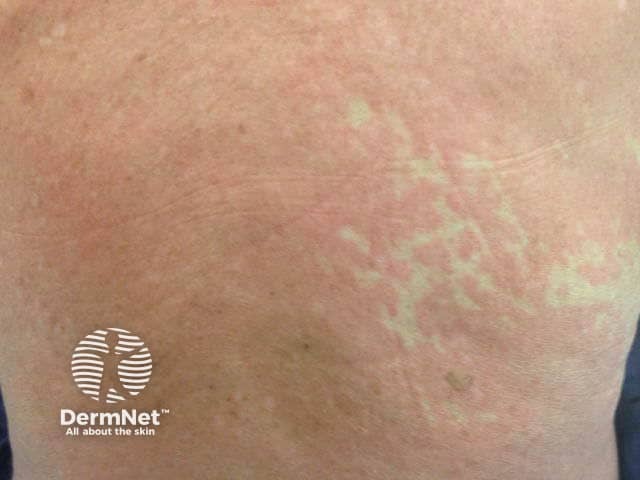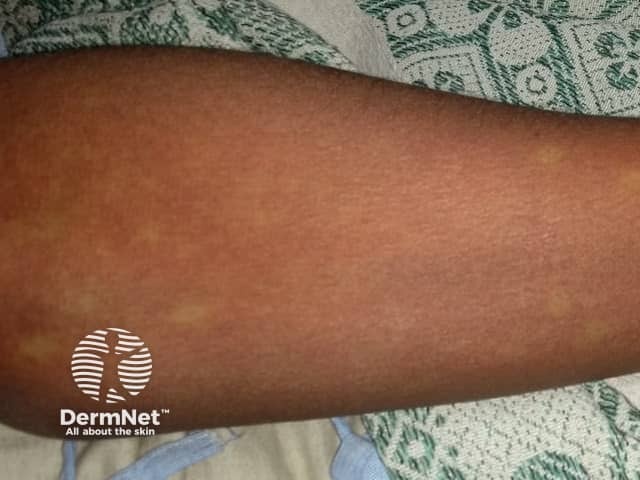Main menu
Common skin conditions

NEWS
Join DermNet PRO
Read more
Quick links
Dengue fever — extra information
Dengue fever
Author: Dr Alexis Daniel Lara Rivero, Dermatologist. Hospital Universitario de Caracas, Venezuela. Reviewed by Dr Margot Whitfeld, Dermatologist, Sydney, Australia. DermNet Editor in Chief, Dr Amanda Oakley. November 2017.
Introduction
Demographics
Causes
Clinical features
Complications
Diagnosis
Differential diagnoses
Treatment
Prevention
What is dengue?
Dengue, or dengue fever, is a viral illness transmitted by the bite of any of dengue viruses. Patients with dengue usually present with fever, headache, rash, nausea, vomiting, aches and pains.
In some cases, dengue can progress to a severe form named severe dengue (previously known as dengue haemorrhagic fever), characterised by plasma leakage with or without haemorrhage. Severe haemorrhage or severe organ impairment can occur, with or without shock features [1].

Exanthem with islands of sparing

Dengue rash
Who gets dengue?
Several hundred years ago, dengue virus probably shifted from a mosquito-monkey-mosquito cycle of transmission to becoming endemic in humans.
There are an estimated 400 million infections in more than 100 countries around the world every year, especially in tropical areas.
Children, the elderly and immunosuppressed individuals tend to be more prone to have atypical or severe forms of dengue virus infection. Severe dengue was first recognised in the 1950s during dengue epidemics in the Philippines and Thailand, but it is now reported worldwide.
The global spread and increasing severity of dengue were enabled by:
- Increased population
- International travel
- Climate change with increasing temperatures in subtropical areas
- More abundant mosquito breeding sites (small pools of fresh water like those in discarded tires, flower vases or uncapped water containers) [1,2].
What causes dengue?
Dengue virus belongs to the family of Flavivirus, the same family of viruses including yellow fever and zika. They are also called arboviruses, because are transmitted by arthropod bites (in the case of dengue by the Aedes mosquitoes, especially Aedes aegypti). Dengue viruses (DENV) are small, spherical, single-stranded enveloped RNA viruses with four distinct viral serotypes, DENV 1–4.
Once a person becomes infected, the virus is carried and multiplies in the blood, serving as a source of the virus for uninfected mosquitoes. Patients who are already infected with the dengue virus can transmit the infection via mosquitoes after the first symptoms appear until a maximum of two weeks later [1,2].
What are the clinical features of dengue?
A person infected by the dengue virus develops severe flu-like symptoms. The clinical features of dengue fever vary according to the characteristics of the infected individual. Symptoms usually last for 2–7 days, after an incubation period of 4–10 days after the bite from an infected mosquito [1,3].
In 2009, WHO re-classified dengue infections as dengue fever and divided it into three groups [1].
Probable dengue fever: fever (usually up to 40°C) plus two of the following:
- Nausea and/or vomiting
- Rash (red and confluent dots and blotches)
- Leukopenia (low white blood cells)
- Aches and pains (‘break-bone’) especially arms and legs
- Positive tourniquet test (a test performed by doctors)
- A retro-ocular headache (pain behind the eyes).
Dengue fever with warning signs: dengue fever plus at least one of the following:
- Abdominal pain or tenderness
- Persisting vomiting
- Mucosal bleeding (from nose and gums)
- Lethargy (somnolence) or restlessness
- Hepatomegaly (enlarged liver)
- Increased haematocrit (a feature of fluid loss)
- Thrombocytopenia (low platelet count)
- Pleural or peritoneal effusion (fluid in the lining of the lungs or the abdominal organs).
Severe dengue: dengue fever plus at least one of the following:
- Kidney failure
- Acute pulmonary oedema (sudden accumulation of fluid in the lungs)
- Shock features (low blood pressure, rapid heart rate)
- Severe bleeding
- Heart failure AST or ALT > 1000 IU (very abnormal liver function tests)
- Altered consciousness level (drowsiness or even coma).
What are the complications of dengue?
The most feared complication of dengue is its severe form. Major bleeding, profound shock, multiple organ failure and brain or heart damage can usually lead to death when present. This is fortunately uncommon [1].
How is dengue diagnosed?
Dengue infection is diagnosed by testing blood samples during the first 5 days of symptoms and/or early recovery phase (more than 5 days of symptoms) confirming the presence of the virus. The diagnosis can also be confirmed by:
- The presence of IgM against dengue virus (IgM is an antibody produced in acute infections); or;
- The increase in IgG titres against dengue virus in two different blood samples (IgG is an antibody produced when the person has been infected before) [4].
What is the differential diagnosis for dengue?
This can be infectious (mostly) or non-infectious conditions.
Infectious conditions
- Viruses: chikungunya, zika, influenza, acute human immunodeficiency virus (HIV) infection, measles, rubella
- Bacteria: leptospirosis, typhoid fever, typhus, bacterial sepsis, scarlet fever
- Protozoa: malaria
Non-infectious conditions
- Inflammatory: systemic lupus erythematosus, adverse reactions to medications
- Haematological disorders: aplastic anaemia, leukaemia, purpura syndromes
What is the treatment of dengue?
There is no specific treatment for dengue fever. Patients should seek medical advice, rest and drink plenty of fluids.
- Paracetamol can be taken to bring down fever and reduce joint pains.
- Aspirin or non-steroidal anti-inflammatories (NSAIDs) such as ibuprofen should not be taken since they can increase the risk of bleeding [1,5].
In the case of severe dengue, the patient should be admitted to hospital for maintenance of the patient's circulating fluid volume and management of haemorrhagic complications.
What is the outcome for dengue?
After recovery from dengue fever, the person develops lifelong immunity against that particular dengue virus serotype but confers only partial and transient protection against the other three serotypes of the virus.
Sequential infections seem to increase the risk of developing severe dengue. The person with non-complicated dengue fever recovers without any residual problem [1].
Prevention of dengue
There is ongoing research about medications and vaccines against dengue virus, and also for reduction and/or elimination of Aedes mosquitoes [1,6].
Vector control
Mosquito breeding sites should be eliminated or controlled. The dengue virus-carrying mosquito often breeds in artificial containers and receptacles containing water. The following measures can be taken to reduce the breeding of mosquitoes.
- Cover all water tanks, cisterns, barrels, rubbish containers.
- Remove or empty water in old tyres, tin cans, bottles, trays.
- Check and clean out clogged gutters and flat roofs where water may have settled.
- Change water regularly in pet water dishes, birdbaths and plant trays.
- Introduce larvivorous fish (such as guppy) to ornamental water features, as these eat mosquito larvae.
- Trim weeds and tall grasses, as adult mosquitoes seek these for shade.
People should avoid being bitten by mosquitoes.
- Wear long sleeves and pants.
- Install secure screens to windows and doors to keep mosquitoes out.
- Use an insect repellent such as DEET.
- Sleep under mosquito curtains or nets, this is particularly important when children are sleeping or resting during daylight hours.
- In high-risk areas, insecticide sprays may be used to kill mosquitoes.
References
- World Health Organisation. Dengue: guidelines for diagnosis, treatment, prevention and control. Geneva: WHO, 2009. PDF file.
- Sharp T, Tomashek K, Read J, et al. A new look at an old disease: recent insights into the global epidemiology of Dengue. Curr Epidemiol Rep 2017; 4:11–21. DOI: 10.1007/s40471-017-0095-y. Journal.
- Thomas E, John M, Kanish B. Mucocutaneous manifestations of Dengue fever. Indian J Dermatol. 2010; 55(1): 79–85. DOI: 10.4103/0019-5154.60359. Journal.
- Centers for Disease Control and Prevention. Dengue: laboratory guidance and diagnostic testing. August 2024. Available at: https://www.cdc.gov/dengue/hcp/diagnosis-testing/index.html
- Tai A, McGuiness S, Robosa R, et al. Management of Dengue in Australian travellers: a retrospective multicentre analysis. Med J Aust 2017; 206 (7): 295–300. DOI: 10.5694/mja16.01056. Journal.
- Low J, Ooi E, Vasudevan S. Current status of Dengue therapeutics: research and development. J Infect Dis 2017; 215(S2): S96–102. DOI: 10.1093/infdis/jiw423. Journal.
On DermNet
- Viral infections
- Zika virus infection
- Insect bites and stings
- Chikungunya fever
- Tropical skin diseases
Other websites
- Dengue — Medline Plus
- Dengue and dengue haemorrhagic fever — World Health Organization (WHO)
- Dengue fever — from Centers for Disease Control and Prevention
- Dengue fever — Medscape Reference
